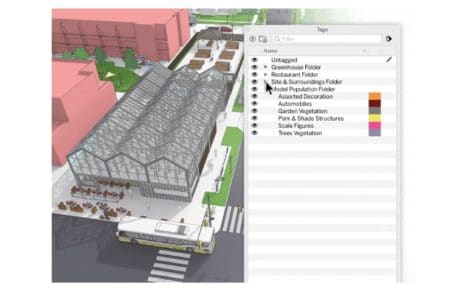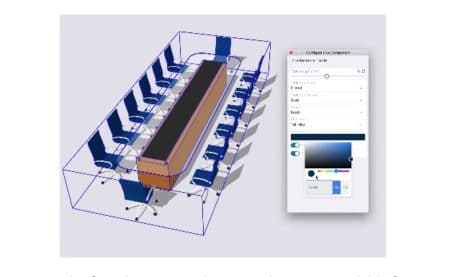Trimble SketchUp this fall introduced a new service for SketchUp professional subscribers which enables architects and designers to test out design strategies against site climate and environmental impact.
The new PreDesign features also produce data and graphics to help users articulate and build a narrative around early-stage climate-related design decisions.
PreDesign with SketchUp
“SketchUp is a fantastic way to develop ideas in 3D and we are continuously exploring new capabilities. We saw tremendous value in making it easy for our users to include design research in their pre-design workflows,” said Andrew Corney, PE, M.CIBSE, M.ASHRAE, product director at Trimble. “With PreDesign, we’re providing designers with the insights they need to take a truly holistic approach to creating suitable design strategies and communicate value to their clients.”

PreDesign is a new feature set inside SketchUp 2021 Professional that helps architects and designers gain insights from design research focused on climate data.
Climate responsiveness is an important factor in building design and energy-related building performance. Even in today’s Greta Thunberg context, building designers often fail to take sufficient action to maximally optimize architecture to building energy performance. At the same time, architects and designers worldwide widely use Trimble’s SketchUp for their early design phase work. So the introduction of PreDesign features for climate response is an excellent fit.
Here is what the PreDesign features help architects and designers focus on:
- Architectural response – connects the dots between the climate and building type, suggesting appropriate architectural responses, such as larger openings to take advantage of outdoor conditions or shading to control adverse solar gain. Armed with this knowledge, architects and designers can create an informed architectural design narrative around climate and build the most efficient building possible.
- Shading – produces an intuitive sun path diagram showing the areas that receive warming sun and indicating areas that are exposed to overheating sun or overcast by cloudy skies—insights that are based on existing weather files. This allows designers to effectively position the built form to take advantage of favorable conditions, such as a well-lit courtyard. PreDesign provides shading guidance specific to any direction and indicates the effectiveness of shading options for optimal climate design.
- Glazing – allows designers to adjust glazing type, framing insulation, solar control, and external shading to better understand the impact of glazing specifications and ensure realistic and budget-friendly materials are specified.
- Daylighting – provides inspiration and clear guidance on the suitability of a wide range of top lighting options, making it easy to find the right solution for beneficial daylight.
- Outside spaces – provides the foresight needed to design functional outdoor spaces, allowing designers to propose strategies such as windbreaks, fans, rain covers, fire pits, and solar-powered lighting.
Architosh readers may recall that recently we published an in-depth product review of SketchUp Studio, the version of SketchUp that comes with environmental analysis design tools originally from Sefaira. In our review of SketchUp 2020, we dove into the many benefits of SketchUp Studio with the Sefaira tools, showing how they aid critical early-stage design and help inform decisions for architects pursuing LEED credits for their building projects.
PreDesign doesn’t provide the Sefaira tools and workflows but does provide many useful features that will help architects and designers understand the impact of climate data for their specific building site. It is the major new feature update in SketchUp 2021. But it is far from the only other really great feature and improvement in SketchUp 2021.
SketchUp 2021 New Features
Add Location is a new feature that brings hi-res aerial imagery for accurate site placement and site context data. In version 2020, as Architosh discussed in its review, SketchUp renamed Layers to Tags. It was more than a name change. Now in version 2021, Trimble SketchUp has added new Tag Folders to help users better organize models by tags, with faster access and bulk visibility control. Basically, what one can say about this new Tag Folders feature is it is equal to layer set visibility control in other CAD and 3D programs. While seemingly simple in terms of its addition, it is a huge win for SketchUp users. They also added a “filter” data field at the top of the Tags palette. So now you can filter Tags like you were able to filter in the Outliner. (see image here from our article, “Product Review: Trimble SketchUp Studio 2020,” 25 Aug 2020).

Tag Folders offer SketchUp users serious new organizational powers—a much-needed feature for large 3D models.
Another new set of updates is with Scenes, with the ability to select and save hidden objects on a scene-by-scene basis. With this latest update, you can save the visibility state of hidden objects and section planes. Another new feature, though small but useful, is the ability to toggle on and off “line inferencing.” Sometimes inferencing—which makes drawing actions snap to the red, green, and blue axes super easy—gets in the way. So now you can turn it off. And SketchUp 2021 introduces a native ‘Weld Edges’ command to join edges and arcs into a single polyline without installing an extension.
Materia and Live Components
Trimble has added new parametric modeling technology to SketchUp 2021 called Materia, which they refer to as a “computational design platform.” The company says that the introduction of Live Components is just the early start of where this new computational design platform will be going. So that is exciting news for SketchUp fans.
Live Components are programmed with modeling logic that controls their geometry vis-a-vis a Live Components configuration palette. One example is a table that can automatically adjust in size complete with updated chairs for the table. The configurator options allow for material and surface color changes to objects in the Live Component, so a table surface could change from wood to glass and chairs can change their materials.
Live Components are found in 3D Warehouse and downloaded into your models. However, the company says that they will bring this ability to create your own Live Components soon. This technology only works with version 2021, of course. Live Components and the Materia computational design platform are launched as part of what Trimble calls SketchUp Labs, a new way for Trimble to introduce new features into users’ hands where they can impact development.
To learn more visit here.
Architosh Analysis and Commentary
The biggest surprise news in this latest version of SketchUp (v.2021) isn’t any of the main features but the introduction of Materia—this new “computational design platform” that Trimble is referring to as the technology behind Live Components. Where Trimble is thinking of going with “computational design” is an open question. The fact that they call it a “platform” and that it will work across other Trimble products (which ones isn’t yet clear) is even more interesting.
The new logo for SketchUp (also introduced with this new version) is another indicator that Trimble has been working hard behind the scenes on some massive changes for the world’s most popular 3D modeling software. There have been rumblings over the years that SketchUp could morph into a full-blown BIM program; many AEC users treat SketchUp models in similar and same ways to conventional BIM models; SketchUp already supports IFC in some capacity. Still, a true BIM program SketchUp is not. At least not yet. On the other hand, the new Tags and Tag Folder and Tag Filters feature all better enable more intensified and larger 3D models at the model management level. This certainly creates an interesting and more robust foundation for where SketchUp goes next.




Reader Comments
Comments for this story are closed